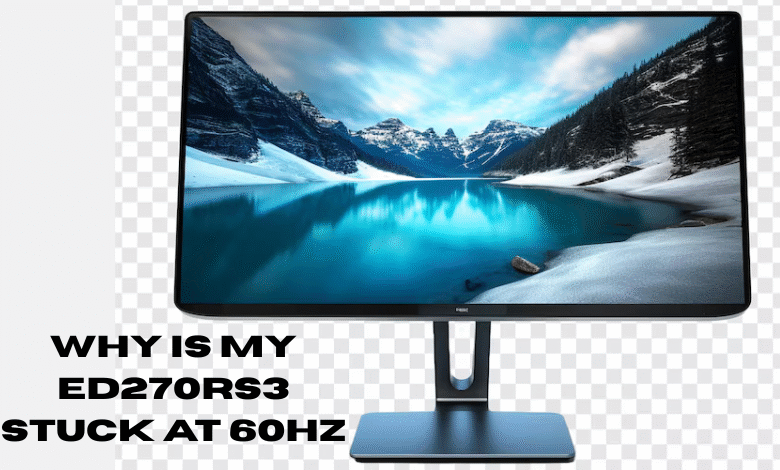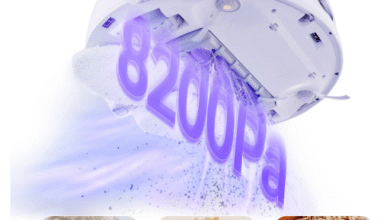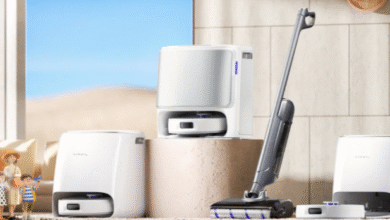Why is my Ed270rs3 Stuck at 60hz? Causes and Solutions

If you’ve noticed that your ED270RS3 monitor is stuck at 60Hz, you’re probably frustrated especially if you know it’s capable of delivering smoother visuals at higher refresh rates like 144Hz or 165Hz. A higher refresh rate can transform your gaming, video editing, or even casual scrolling into a much more enjoyable experience. So, why isn’t your monitor performing at its best? Don’t worry I’m here to walk you through the reasons and fixes in a way that’s easy to follow and actually works.
In this article, we’ll break down the most common culprits behind your monitor being locked at 60Hz and give you practical, step-by-step solutions to get it running at its full potential. From simple settings tweaks to hardware checks, we’ll cover it all. Plus, I’ve included some handy tables and an FAQ section to answer those lingering questions. Let’s get started!
What Is a Refresh Rate, and Why Does It Matter?
Before we jump into the “why” and “how,” let’s get clear on what a refresh rate actually is. Simply put, the refresh rate is how many times your monitor updates the image on the screen every second, measured in Hertz (Hz). A 60Hz monitor refreshes 60 times per second, while a 144Hz monitor refreshes 144 times. The higher the number, the smoother everything looks especially when you’re gaming or watching fast-moving content.
If your ED270RS3 is stuck at 60Hz, you’re missing out on that buttery-smooth experience it’s designed to deliver. Assuming it’s a monitor built for higher refresh rates (most models with similar naming conventions are), let’s figure out what’s holding it back.
Why Is My ED270RS3 Stuck at 60Hz? The Top Reasons
There are a handful of usual suspects when a monitor won’t go beyond 60Hz. Let’s break them down one by one.
Reason 1: Your Display Settings Are Set to 60Hz
This is the most common issue and the easiest to fix. Your operating system (like Windows) might not automatically detect your monitor’s full capabilities and could default to 60Hz. It’s not your monitor’s fault; it’s just waiting for the right instructions.
Reason 2: The Cable You’re Using Can’t Handle More
Not all cables are created equal. If you’re using an older HDMI cable, for example, it might max out at 60Hz, even if your monitor and graphics card can do more. The type and version of your cable matter a lot.
Reason 3: Your Graphics Card Might Be the Bottleneck
Your graphics card (GPU) needs to support higher refresh rates too. If it’s an older model or doesn’t have the right output ports, it could be capping your monitor at 60Hz, no matter what the monitor itself can do.
Reason 4: Monitor Settings Need a Tweak
Sometimes, the monitor’s own settings accessed through its On-Screen Display (OSD) menu default to 60Hz. If you haven’t poked around in there, it might just need a quick adjustment.
Reason 5: Outdated Graphics Drivers Are Holding You Back
Graphics drivers are like the middleman between your GPU and your monitor. If they’re outdated or buggy, they might not communicate the full range of refresh rates your setup supports.
Reason 6: Your Device or Console Is Limiting It
If you’re not using a PC but a console or another device, that could be the issue. Older consoles like the PS4 or Xbox One, for instance, often cap at 60Hz, even if your monitor can handle more.
How to Fix Your ED270RS3 Monitor Stuck at 60Hz
Now that we’ve pinpointed the likely causes, let’s get to the fixes. Follow these steps in order, and you’ll likely solve the problem. I’ll keep it simple and actionable.
Step 1: Adjust Your Display Settings
Let’s start with the basics checking your computer’s display settings.
For Windows 10 or 11:
-
Right-click anywhere on your desktop and pick Display settings.
-
Scroll down to Advanced display settings and click it.
-
Look for the Refresh rate dropdown. If it’s set to 60Hz, change it to something higher (like 144Hz or 165Hz).
-
Hit Apply. If the screen looks good, you’re set! If not, or if 60Hz is the only option, keep going.
For macOS:
-
Click the Apple menu and go to System Settings (or System Preferences on older versions).
-
Select Displays.
-
Check the Refresh Rate option and switch it to the highest available.
-
If it’s stuck at 60Hz, move to the next step.
Step 2: Check and Swap Your Cable
Your cable could be the weak link. Here’s what to do:
-
Check the cable type: Look at what you’re using HDMI or DisplayPort? Then check the version (it’s usually printed on the cable or in the manual).
-
HDMI limitations: HDMI 1.4 tops out at 60Hz for higher resolutions like 1440p. HDMI 2.0 or 2.1 can handle 144Hz and beyond.
-
DisplayPort advantage: DisplayPort 1.2 or higher usually supports 144Hz or more, even at 1440p or 4K.
-
Swap it out: If you’ve got an older cable, grab a high-speed HDMI 2.0 (or better) or DisplayPort 1.4 cable and test again.
Pro tip: Avoid cheap, unbranded cables they might not deliver the bandwidth you need.
Step 3: Update Your Graphics Drivers
Old drivers can cause all sorts of headaches. Here’s how to update them:
Quick Method (Automatic):
-
Open Device Manager (type it into the Windows search bar).
-
Expand Display adapters.
-
Right-click your GPU (like NVIDIA GeForce or AMD Radeon) and choose Update driver.
-
Select Search automatically for drivers and let Windows do its thing.
Better Method (Manual):
-
Head to your GPU maker’s website:
-
NVIDIA
-
AMD
-
Intel
-
-
Find your GPU model, download the latest driver, and install it.
-
Restart your PC and check the refresh rate again.
Step 4: Tweak Your Monitor’s OSD Menu
Your monitor might need a nudge from its own settings.
-
Find the buttons on your ED270RS3 (usually on the bottom or side).
-
Press the menu button to bring up the OSD.
-
Look for a section like Display, Picture, or Settings.
-
Find Refresh Rate or Frequency and set it to 144Hz (or the highest option).
-
Save and exit.
Some monitors have a “gaming mode” or overclock setting check for that too.
Step 5: Verify Your Graphics Card’s Capabilities
Your GPU has to be up to the task. Here’s how to check:
-
Look up your GPU: Google your model (e.g., “NVIDIA GTX 1660 specs”) and see its max refresh rate and supported ports.
-
Match the port: If it’s got DisplayPort 1.4, use that over HDMI for higher refresh rates.
-
Upgrade if needed: If your GPU maxes out at 60Hz for your resolution, you might need a newer card.
Step 6: Account for Device Limitations
Using something other than a PC? Here’s what to know:
-
PS4/Xbox One: Locked at 60Hz, no matter your monitor.
-
PS5/Xbox Series X: Can hit 120Hz with the right cable and settings.
-
Laptops: Check your laptop’s GPU and output port some integrated graphics (like Intel UHD) cap at 60Hz.
If your device can’t go higher, you’re stuck unless you switch to a capable PC.
Extra Troubleshooting Tips When Nothing Else Works
Still stuck at 60Hz? Don’t give up yet try these:
-
Restart everything: Power off your PC and monitor, unplug them for a minute, then reboot.
-
Test another port: If your GPU has multiple HDMI or DisplayPort outputs, switch to a different one.
-
Reset the monitor: In the OSD, look for a “Factory Reset” option and give it a go.
-
Try another device: Hook your ED270RS3 to a different PC or laptop. If it hits 144Hz there, the issue’s with your original setup.
-
Update Windows: Go to Settings > Windows Update and install any pending updates sometimes they fix display bugs.
Helpful Comparison Tables
Let’s make things visual with some tables to clarify cables and GPUs.
Table 1: Cable Types and Refresh Rate Limits
|
Cable Type |
Max Refresh Rate at 1080p |
Max Refresh Rate at 1440p |
Max Refresh Rate at 4K |
|---|---|---|---|
|
HDMI 1.4 |
120Hz |
60Hz |
30Hz |
|
HDMI 2.0 |
240Hz |
144Hz |
60Hz |
|
HDMI 2.1 |
240Hz+ |
240Hz+ |
120Hz+ |
|
DisplayPort 1.2 |
240Hz |
165Hz |
60Hz |
|
DisplayPort 1.4 |
240Hz+ |
240Hz+ |
120Hz+ |
Takeaway: For 144Hz or more, stick to HDMI 2.0+ or DisplayPort 1.2+.
Table 2: Graphics Cards and Their Refresh Rate Support
|
Graphics Card |
Max Refresh Rate at 1080p |
Max Refresh Rate at 1440p |
Max Refresh Rate at 4K |
|---|---|---|---|
|
NVIDIA GTX 1060 |
240Hz |
120Hz |
60Hz |
|
NVIDIA RTX 3060 |
240Hz |
240Hz |
120Hz |
|
AMD RX 580 |
240Hz |
144Hz |
60Hz |
|
AMD RX 6800 |
240Hz+ |
240Hz+ |
120Hz+ |
|
Intel UHD Graphics 620 |
60Hz |
60Hz |
60Hz |
Takeaway: Older or integrated GPUs might not cut it check yours!
FAQ: Your Most Common Questions Answered
Got more questions? Here are answers to some popular ones.
Why won’t my monitor go above 60Hz even after changing settings?
It could be your cable (e.g., an old HDMI 1.4) or GPU not supporting higher rates. Double-check both, and update your drivers too.
How do I check if my monitor is running at 144Hz?
In Windows, go to Display settings > Advanced display settings it’ll show the current refresh rate. You can also use online tools like TestUFO to confirm.
Can a bad cable really limit my refresh rate?
Yep! A low-quality or outdated cable (like HDMI 1.0) can bottleneck your setup. Swap it for a certified high-speed one.
What if my graphics card only supports 60Hz?
If your GPU can’t handle more than 60Hz at your resolution, you’ll need to upgrade it to unlock higher refresh rates.
How do I change my monitor refresh rate on a console?
Consoles like the PS5 let you adjust this in Settings > Screen and Video > Video Output. But older ones (PS4) are stuck at 60Hz.
Wrapping It Up
If your ED270RS3 monitor is stuck at 60Hz, it’s usually one of these: wrong settings, a limited cable, an outdated GPU or driver, or a device that can’t keep up. By walking through the fixes starting with your display settings and working your way to hardware checks you should be able to get that smooth 144Hz (or higher) experience you’re after.
Take it one step at a time, and don’t skip the cable check it’s a sneaky culprit! If all else fails, test your monitor on another system to narrow it down. Once you’ve got it sorted, you’ll wonder how you ever lived with 60Hz. Happy gaming or whatever you’re using that monitor for!



